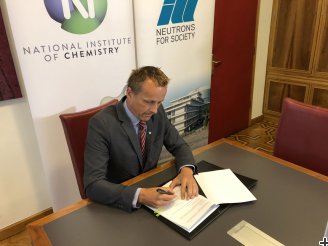Copyright 2012 neutronsources.org | All rights reserved. | Powered by FRM II | Imprint / Privacy Policy
Slovenia is now a member state of the ILL
Date: 4 September 2020
Source: ILL
Slovenia’s National Institute of Chemistry (NIC) joins the world’s flagship neutron science facility, the Institut Laue-Langevin (ILL), as a Scientific Member, opening the door for Slovenia’s scientists and industry to cutting-edge research with neutrons, to drive innovation and tackle global challenges.
Slovenian scientists and businesses will now have direct access to the most powerful neutron source in use worldwide, with ILL home to some 40 state-of-the-art instruments that use neutrons to probe and explore matter, aiding the development of drugs, more efficient batteries, our understanding of nuclear physics, and much more. This is because neutrons have a unique interaction with matter and are deeply penetrating and non-destructive, revealing precise details of the atomic make-up and material behaviour.
The agreement comes at a crucial time for science and international collaboration – researchers around the world are focussing considerable effort to study coronavirus, while research facilities are opening up slowly after national lockdowns. Indeed the ILL reactor is currently operating and the first Covid-19 related research is being performed.
Slovenian researchers rank among the most prolific authors in Europe and the country has an above-average number of PhD students. Slovenia’s academic institutions and highly-active research community will therefore form a winning partnership with ILL.
As such, ILL and NIC are encouraging academic researchers and industry throughout Slovenia to submit proposals this September to start using the facility from as early as January 2021.
ILL is governed by its three founding countries – France, Germany, and the United Kingdom – with its 11 Scientific Member countries providing further funding with access to the ILL’s instruments and expertise.
The National Institute of Chemistry (NIC), a research facility based in Ljubljana, will act as the ILL’s official partner in Slovenia initially until 2023. The NIC will take on the scientific and administrative duties to manage Slovenia’s membership, and coordinate the country’s scientific community in its use of the resources at ILL. Funding for the cooperation will be provided by the Slovenian Research Agency as part of the NIC research infrastructure.
Prof Mark Johnson, Scientific Director, ILL, said “International scientific cooperation is more important than ever. It is a great pleasure to welcome Slovenia as one of our Scientific Members; the scientific excellence of our institution will be enhanced by the participation of Slovenia’s world-class researchers and academic organisations, who we welcome to submit proposals from this September. Slovenian industry can also benefit from new neutron techniques and resources to drive their research and development, helping companies on their innovation journeys.”
Prof Gregor Anderluh, Director of the National Institute of Chemistry, said “Membership of the ILL will provide unprecedented opportunities for the scientific community in Slovenia to participate in European research efforts, and contribute to world-leading research in vital areas such as chemistry, energy, health, and engineering. We are very excited to facilitate what will be a stimulating partnership between Slovenia and the ILL. The world-class instruments and expertise at the ILL offers great potential to enhance the innovation and discovery being driven by Slovenian researchers. It may also reveal new possibilities for the community to address both local and global challenges through novel collaborations and cutting-edge science, and we encourage researchers to propose their experiments.”
